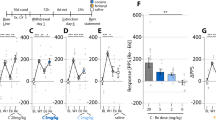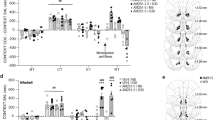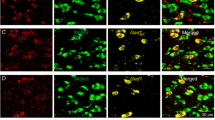Abstract
Drug addiction is driven, in part, by powerful and enduring memories of sensory cues associated with drug intake. As such, relapse to drug use during abstinence is frequently triggered by an encounter with drug-associated cues, including the drug itself. L-type Ca2+ channels (LTCCs) are known to regulate different forms of synaptic plasticity, the major neural substrate for learning and memory, in various brain areas. Long-term potentiation (LTP) of NMDA receptor (NMDAR)-mediated glutamatergic transmission in the ventral tegmental area (VTA) may contribute to the increased motivational valence of drug-associated cues triggering relapse. In this study, using rat brain slices, we found that isradipine, a general LTCC antagonist used as antihypertensive medication, not only blocks the induction of NMDAR LTP but also promotes the reversal of previously induced LTP in the VTA. In behaving rats, isradipine injected into the VTA suppressed the acquisition of cocaine-paired contextual cue memory assessed using a conditioned place preference (CPP) paradigm. Furthermore, administration of isradipine or a CaV1.3 subtype-selective LTCC antagonist (systemic or intra-VTA) before a single extinction or reinstatement session, while having no immediate effect at the time of administration, abolished previously acquired cocaine and alcohol (ethanol) CPP on subsequent days. Notably, CPP thus extinguished cannot be reinstated by drug re-exposure, even after 2 weeks of withdrawal. These results suggest that LTCC blockade during exposure to drug-associated cues may cause unlearning of the increased valence of those cues, presumably via reversal of glutamatergic synaptic plasticity in the VTA.
This is a preview of subscription content, access via your institution
Access options
Subscribe to this journal
Receive 12 print issues and online access
$259.00 per year
only $21.58 per issue
Buy this article
- Purchase on Springer Link
- Instant access to full article PDF
Prices may be subject to local taxes which are calculated during checkout





Similar content being viewed by others
References
Wise RA, Kiyatkin EA . Differentiating the rapid actions of cocaine. Nat Rev Neurosci 2011; 12: 479–484.
Robinson TE, Yager LM, Cogan ES, Saunders BT . On the motivational properties of reward cues: individual differences. Neuropharmacology 2014; 76 (Pt B): 450–459.
Volkow ND, Wang GJ, Fowler JS, Tomasi D, Telang F, Baler R . Addiction: decreased reward sensitivity and increased expectation sensitivity conspire to overwhelm the brain's control circuit. Bioessays 2010; 32: 748–755.
Hyman SE, Malenka RC, Nestler EJ . Neural mechanisms of addiction: the role of reward-related learning and memory. Annu Rev Neurosci 2006; 29: 565–598.
Kauer JA, Malenka RC . Synaptic plasticity and addiction. Nat Rev Neurosci 2007; 8: 844–858.
Luthi A, Luscher C . Pathological circuit function underlying addiction and anxiety disorders. Nat Neurosci 2014; 17: 1635–1643.
Schultz W . Predictive reward signal of dopamine neurons. J Neurophysiol 1998; 80: 1–27.
Overton PG, Clark D . Burst firing in midbrain dopaminergic neurons. Brain Res Brain Res Rev 1997; 25: 312–334.
Zweifel LS, Parker JG, Lobb CJ, Rainwater A, Wall VZ, Fadok JP et al. Disruption of NMDAR-dependent burst firing by dopamine neurons provides selective assessment of phasic dopamine-dependent behavior. Proc Natl Acad Sci USA 2009; 106: 7281–7288.
Morikawa H, Khodakhah K, Williams JT . Two intracellular pathways mediate metabotropic glutamate receptor-induced Ca2+ mobilization in dopamine neurons. J Neurosci 2003; 23: 149–157.
Wang LP, Li F, Wang D, Xie K, Wang D, Shen X et al. NMDA receptors in dopaminergic neurons are crucial for habit learning. Neuron 2011; 72: 1055–1066.
Deister CA, Teagarden MA, Wilson CJ, Paladini CA . An intrinsic neuronal oscillator underlies dopaminergic neuron bursting. J Neurosci 2009; 29: 15888–15897.
Blythe SN, Atherton JF, Bevan MD . Synaptic activation of dendritic AMPA and NMDA receptors generates transient high-frequency firing in substantia nigra dopamine neurons in vitro. J Neurophysiol 2007; 97: 2837–2850.
Harnett MT, Bernier BE, Ahn KC, Morikawa H . Burst-timing-dependent plasticity of NMDA receptor-mediated transmission in midbrain dopamine neurons. Neuron 2009; 62: 826–838.
Brown J, Bullock D, Grossberg S . How the basal ganglia use parallel excitatory and inhibitory learning pathways to selectively respond to unexpected rewarding cues. J Neurosci 1999; 19: 10502–10511.
Cui G, Bernier BE, Harnett MT, Morikawa H . Differential regulation of action potential- and metabotropic glutamate receptor-induced Ca2+ signals by inositol 1,4,5-trisphosphate in dopaminergic neurons. J Neurosci 2007; 27: 4776–4785.
Zuccotti A, Clementi S, Reinbothe T, Torrente A, Vandael DH, Pirone A . Structural and functional differences between L-type calcium channels: crucial issues for future selective targeting. Trends Pharmacol Sci 2011; 32: 366–375.
Lipscombe D, Helton TD, Xu W . L-type calcium channels: the low down. J Neurophysiol 2004; 92: 2633–2641.
Rajadhyaksha A, Husson I, Satpute SS, Kuppenbender KD, Ren JQ, Guerriero RM et al. L-type Ca2+ channels mediate adaptation of extracellular signal-regulated kinase 1/2 phosphorylation in the ventral tegmental area after chronic amphetamine treatment. J Neurosci 2004; 24: 7464–7476.
Chan CS, Guzman JN, Ilijic E, Mercer JN, Rick C, Tkatch T et al. 'Rejuvenation' protects neurons in mouse models of Parkinson's disease. Nature 2007; 447: 1081–1086.
Guzman JN, Sanchez-Padilla J, Wokosin D, Kondapalli J, Ilijic E, Schumacker PT et al. Oxidant stress evoked by pacemaking in dopaminergic neurons is attenuated by DJ-1. Nature 2010; 468: 696–700.
Branch SY, Sharma R, Beckstead MJ . Aging decreases L-type calcium channel currents and pacemaker firing fidelity in substantia nigra dopamine neurons. J Neurosci 2014; 34: 9310–9318.
Pani L, Kuzmin A, Martellotta MC, Gessa GL, Fratta W . The calcium antagonist PN 200-110 inhibits the reinforcing properties of cocaine. Brain Res Bull 1991; 26: 445–447.
Pucilowski O, Plaznik A, Overstreet DH . Isradipine suppresses amphetamine-induced conditioned place preference and locomotor stimulation in the rat. Neuropsychopharmacology 1995; 12: 239–244.
Biala G, Langwinski R . Effects of calcium channel antagonists on the reinforcing properties of morphine, ethanol and cocaine as measured by place conditioning. J Physiol Pharmacol 1996; 47: 497–502.
Pucilowski O, Garges PL, Rezvani AH, Hutheson S, Janowsky DS . Verapamil suppresses d-amphetamine-induced place preference conditioning. Eur J Pharmacol 1993; 240: 89–92.
Wang LP, Li F, Shen X, Tsien JZ . Conditional knockout of NMDA receptors in dopamine neurons prevents nicotine-conditioned place preference. PLoS One 2010; 5: e8616.
Zweifel LS, Argilli E, Bonci A, Palmiter RD . Role of NMDA receptors in dopamine neurons for plasticity and addictive behaviors. Neuron 2008; 59: 486–496.
Tzschentke TM . Measuring reward with the conditioned place preference (CPP) paradigm: update of the last decade. Addict Biol 2007; 12: 227–462.
Engblom D, Bilbao A, Sanchis-Segura C, Dahan L, Perreau-Lenz S, Balland B et al. Glutamate receptors on dopamine neurons control the persistence of cocaine seeking. Neuron 2008; 59: 497–508.
Whitaker LR, Degoulet M, Morikawa H . Social deprivation enhances VTA synaptic plasticity and drug-induced contextual learning. Neuron 2013; 77: 335–345.
Ahn KC, Bernier BE, Harnett MT, Morikawa H . IP3 receptor sensitization during in vivo amphetamine experience enhances NMDA receptor plasticity in dopamine neurons of the ventral tegmental area. J Neurosci 2010; 30: 6689–6699.
Bernier BE, Whitaker LR, Morikawa H . Previous ethanol experience enhances synaptic plasticity of NMDA receptors in the ventral tegmental area. J Neurosci 2011; 31: 5205–5212.
Khaliq ZM, Bean BP . Pacemaking in dopaminergic ventral tegmental area neurons: depolarizing drive from background and voltage-dependent sodium conductances. J Neurosci 2010; 30: 7401–7413.
Koulchitsky S, De Backer B, Quertemont E, Charlier C, Seutin V . Differential effects of cocaine on dopamine neuron firing in awake and anesthetized rats. Neuropsychopharmacology 2012; 37: 1559–1571.
Ungless MA, Whistler JL, Malenka RC, Bonci A . Single cocaine exposure in vivo induces long-term potentiation in dopamine neurons. Nature 2001; 411: 583–587.
Borgland SL, Malenka RC, Bonci A . Acute and chronic cocaine-induced potentiation of synaptic strength in the ventral tegmental area: electrophysiological and behavioral correlates in individual rats. J Neurosci 2004; 24: 7482–7490.
Yuan T, Mameli M, O' Connor EC, Dey PN, Verpelli C, Sala C et al. Expression of cocaine-evoked synaptic plasticity by GluN3A-containing NMDA receptors. Neuron 2013; 80: 1025–1038.
Mameli M, Bellone C, Brown MT, Luscher C . Cocaine inverts rules for synaptic plasticity of glutamate transmission in the ventral tegmental area. Nat Neurosci 2011; 14: 414–416.
Chen BT, Bowers MS, Martin M, Hopf FW, Guillory AM, Carelli RM et al. Cocaine but not natural reward self-administration nor passive cocaine infusion produces persistent LTP in the VTA. Neuron 2008; 59: 288–297.
Bellone C, Luscher C . Cocaine triggered AMPA receptor redistribution is reversed in vivo by mGluR-dependent long-term depression. Nat Neurosci 2006; 9: 636–641.
Kang S, Cooper G, Dunne SF, Dusel B, Luan CH, Surmeier DJ et al. CaV1.3-selective L-type calcium channel antagonists as potential new therapeutics for Parkinson's disease. Nat Commun 2012; 3: 1146.
Torregrossa MM, Taylor JR . Learning to forget: manipulating extinction and reconsolidation processes to treat addiction. Psychopharmacology (Berl) 2013; 226: 659–672.
Milton AL, Everitt BJ . The persistence of maladaptive memory: addiction, drug memories and anti-relapse treatments. Neurosci Biobehav Rev 2012; 36: 1119–1139.
Xue YX, Luo YX, Wu P, Shi HS, Xue LF, Chen C et al. A memory retrieval-extinction procedure to prevent drug craving and relapse. Science 2012; 336: 241–245.
Lee AM, Kanter BR, Wang D, Lim JP, Zou ME, Qiu C et al. Prkcz null mice show normal learning and memory. Nature 2013; 493: 416–419.
Li YQ, Xue YX, He YY, Li FQ, Xue LF, Xu CM et al. Inhibition of PKMzeta in nucleus accumbens core abolishes long-term drug reward memory. J Neurosci 2011; 31: 5436–5446.
Group PS. Phase II safety, tolerability, and dose selection study of isradipine as a potential disease-modifying intervention in early Parkinson's disease (STEADY-PD). Mov Disord 2013; 28: 1823–1831.
Ilijic E, Guzman JN, Surmeier DJ . The L-type channel antagonist isradipine is neuroprotective in a mouse model of Parkinson's disease. Neurobiol Dis 2011; 43: 364–371.
Moosmang S, Haider N, Klugbauer N, Adelsberger H, Langwieser N, Muller J et al. Role of hippocampal Cav1.2 Ca2+ channels in NMDA receptor-independent synaptic plasticity and spatial memory. J Neurosci 2005; 25: 9883–9892.
Seoane A, Massey PV, Keen H, Bashir ZI, Brown MW . L-type voltage-dependent calcium channel antagonists impair perirhinal long-term recognition memory and plasticity processes. J Neurosci 2009; 29: 9534–9544.
Adermark L, Lovinger DM . Combined activation of L-type Ca2+ channels and synaptic transmission is sufficient to induce striatal long-term depression. J Neurosci 2007; 27: 6781–6787.
Wang Z, Kai L, Day M, Ronesi J, Yin HH, Ding J et al. Dopaminergic control of corticostriatal long-term synaptic depression in medium spiny neurons is mediated by cholinergic interneurons. Neuron 2006; 50: 443–452.
Hunt DL, Castillo PE . Synaptic plasticity of NMDA receptors: mechanisms and functional implications. Curr Opin Neurobiol 2012; 22: 496–508.
Rebola N, Srikumar BN, Mulle C . Activity-dependent synaptic plasticity of NMDA receptors. J Physiol 2010; 588: 93–99.
Bauer EP, Schafe GE, LeDoux JE . NMDA receptors and L-type voltage-gated calcium channels contribute to long-term potentiation and different components of fear memory formation in the lateral amygdala. J Neurosci 2002; 22: 5239–5249.
Langwieser N, Christel CJ, Kleppisch T, Hofmann F, Wotjak CT, Moosmang S . Homeostatic switch in hebbian plasticity and fear learning after sustained loss of Cav1.2 calcium channels. J Neurosci 2010; 30: 8367–8375.
Davis SE, Bauer EP . L-type voltage-gated calcium channels in the basolateral amygdala are necessary for fear extinction. J Neurosci 2012; 32: 13582–13586.
Pare D, Duvarci S . Amygdala microcircuits mediating fear expression and extinction. Curr Opin Neurobiol 2012; 22: 717–723.
Nabavi S, Fox R, Proulx CD, Lin JY, Tsien RY, Malinow R . Engineering a memory with LTD and LTP. Nature 2014; 511: 348–352.
Hardingham GE, Bading H . Synaptic versus extrasynaptic NMDA receptor signalling: implications for neurodegenerative disorders. Nat Rev Neurosci 2010; 11: 682–696.
Turrigiano G . Homeostatic synaptic plasticity: local and global mechanisms for stabilizing neuronal function. Cold Spring Harb Perspect Biol 2012; 4: a005736.
Pan WX, Schmidt R, Wickens JR, Hyland BI . Tripartite mechanism of extinction suggested by dopamine neuron activity and temporal difference model. J Neurosci 2008; 28: 9619–9631.
Anderson SM, Famous KR, Sadri-Vakili G, Kumaresan V, Schmidt HD, Bass CE et al. CaMKII: a biochemical bridge linking accumbens dopamine and glutamate systems in cocaine seeking. Nat Neurosci 2008; 11: 344–353.
Johnson BA, Javors MA, Lam YW, Wells LT, Tiouririne M, Roache JD et al. Kinetic and cardiovascular comparison of immediate-release isradipine and sustained-release isradipine among non-treatment-seeking, cocaine-dependent individuals. Prog Neuropsychopharmacol Biol Psychiatry 2005; 29: 15–20.
Roache JD, Johnson BA, Ait-Daoud N, Mauldin JB, Thornton JE, Wells LT et al. Effects of repeated-dose isradipine on the abuse liability of cocaine. Exp Clin Psychopharmacol 2005; 13: 319–326.
Johnson BA, Roache JD, Ait-Daoud N, Wallace CL, Wells LT, Wang Y et al. Effects of isradipine on cocaine-induced changes in cognitive performance in recently abstinent cocaine-dependent individuals. Int J Neuropsychopharmacol 2005; 8: 549–556.
Acknowledgements
We thank Dr D James Surmeier for compound 8 and Dr Kamran Khodakhah for caged IP3. We also thank Garry Cooper for helpful discussions on the effect and usage of compound 8. This work was supported by NIH grants DA015687 and AA015521.
Author information
Authors and Affiliations
Corresponding author
Ethics declarations
Competing interests
The authors declare no conflict of interest.
Additional information
Supplementary Information accompanies the paper on the Molecular Psychiatry website
Supplementary information
Rights and permissions
About this article
Cite this article
Degoulet, M., Stelly, C., Ahn, KC. et al. L-type Ca2+ channel blockade with antihypertensive medication disrupts VTA synaptic plasticity and drug-associated contextual memory. Mol Psychiatry 21, 394–402 (2016). https://doi.org/10.1038/mp.2015.84
Received:
Revised:
Accepted:
Published:
Issue Date:
DOI: https://doi.org/10.1038/mp.2015.84
This article is cited by
-
Ca2+ channel blockade reduces cocaine’s vasoconstriction and neurotoxicity in the prefrontal cortex
Translational Psychiatry (2021)
-
Cocaine-induced ischemia in prefrontal cortex is associated with escalation of cocaine intake in rodents
Molecular Psychiatry (2020)
-
Cocaine- and stress-primed reinstatement of drug-associated memories elicit differential behavioral and frontostriatal circuit activity patterns via recruitment of L-type Ca2+ channels
Molecular Psychiatry (2020)
-
A ventral CA1 to nucleus accumbens core engram circuit mediates conditioned place preference for cocaine
Nature Neuroscience (2019)
-
Role of prefrontal cortex in the extinction of drug memories
Psychopharmacology (2019)



